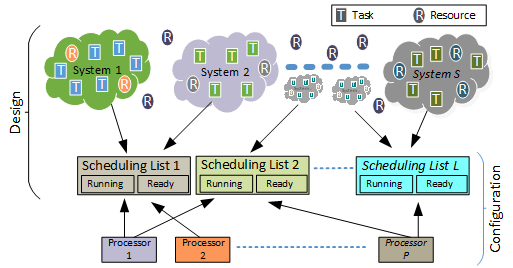Introduction to GeMRTOS: Hybrid partition scheduling. #
This document provides a technical reference of the GeMRTOS multiprocessor system architecture for facilitating real-time multitasking processing. In GeMRTOS, each task is assigned to a list of tasks and one or more processors may serve that list (FIG. 1). Processors may serve one or more lists of tasks, thereby allowing the predictability of partitioned scheduling with a flexible balance of processor loads. Scheduling overhead is reduced using a timer-tickless scheduler. Floating scheduling reduces the overhead for the highest priority tasks and isolates the design of the system from the number of processors of the hardware architecture. The generic feature allows partial configuring, global and partitioned scheduling. Hybrid partition scheduling are based on scheduling lists which allow assigning tasks and processors to scheduling the different subsystems of the application.

Scheduling mechanism, priority disciplines, number of processors and fault-tolerance strategies can be global or partitioned and partially or totally implemented in the generic, timer-tickless and event-driven GeMRTOS system. The event-driven nature of the GeMRTOS system lets it produce low-overhead and high predictability. The frozen and unfrozen modes allow a responsive mechanism suitable for both fault tolerance implementations and the management of saturated situations.
Hybrid partition scheduling #
The hybrid partition scheduling allows assigning tasks, as well as processors to schedule subsystems. Scheduling lists allow sharing processors among subsystem scheduler.



